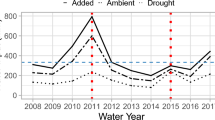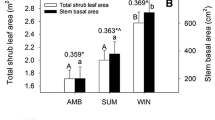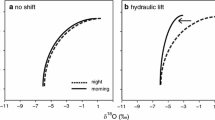Abstract
Whole-plant hydraulics provide important information about responses to water limitation and can be used to understand how plant communities may change in a drier climate when measured on multiple species. Here, we measured above- and belowground hydraulic traits in Cornus drummondii, an encroaching shrub within North American tallgrass prairies, and Andropogon gerardii, a dominant C4 grass, to assess the potential hydraulic responses to future drought as this region undergoes woody expansion. Shelters that reduced precipitation by 50% and 0% were built over shrubs and grasses growing in sites that are burned at 1-year and 4-year frequencies. We then measured aboveground (Kshoot), belowground (Kroot), and whole-plant maximum hydraulic conductance (Kplant) in C. drummondii and Kroot in A. gerardii. We also measured vulnerability to embolism (P50) in C. drummondii stems. Overall, we show that: (1) A. gerardii had substantially greater Kroot than C. drummondii; (2) belowground hydraulic functioning was linked with aboveground processes; (3) above- and belowground C. drummondii hydraulics were not negatively impacted by the rainfall reductions imposed here. These results suggest that a multi-year drought will not ameliorate rates of woody expansion and highlight key differences in aboveground and belowground hydraulics for dominant species within the same ecosystem.






Similar content being viewed by others
Availability of data and material
Data used in this study are available upon request.
Code availability
Not applicable.
References
Alder NN, Pockman WT, Sperry JS, Nuismer S (1997) Use of centrifugal force in the study of xylem cavitation. J Exp Bot 48:665–674
Anderegg WRL, Plavcová L, Anderegg LDL et al (2013) Drought’s legacy: multiyear hydraulic deterioration underlies widespread aspen forest die-off and portends increased future risk. Glob Chang Biol 19:1188–1196
Anderegg WRL, Flint A, Huang CY et al (2015) Tree mortality predicted from drought-induced vascular damage. Nat Geosci 8:367–371
Anderegg WRL, Wolf A, Arango-Velez A et al (2018) Woody plants optimise stomatal behaviour relative to hydraulic risk. Ecol Lett 21:968–977
Archer SR (2010) Rangeland conservation and shrub encroachment new perspectives on an old problem. In: DuToit JT, Kock R, Deutsh JC (eds) Wild Rangelands: conserving wildlife while maintaining livestock in semi-arid ecosystems, vol 8. Blackwell Publishing, New York, pp 53–97
Archer S, Schimel DS, Holland EA (1995) Mechanisms of shrubland expansion: land use, climate or CO2? Clim Change 29:91–99
Archer SR, Andersen EM, Predick KI, et al (2017) Woody plant encroachment: causes and consequences. Rangeland systems: Processes, management and challenges. p 25–84.
Belovitch MW, NeSmith JE, Nippert JB, Holdo RM (2023) African savanna grasses outperform trees across the full spectrum of soil moisture availability. New Phytol 239:66–74
Bittencourt PR, Oliveira RS, da Costa AC, Giles AL, Coughlin I, Costa PB, Bartholomew DC, Ferreira LV, Vasconcelos SS, Barros FV, Junior JA (2020) Amazonia trees have limited capacity to acclimate plant hydraulic properties in response to long-term drought. Glob Change Biol 26(6):3569–3584
Briggs JM, Knapp AK (1995) Interannual variability in primary production in tallgrass prairie: climate, soil moisture, topographic position, and fire as determinants of aboveground biomass. Am J Bot 82:1024–1030
Briggs JM, Knapp AK, Blair JM, Heisler JL (2005) An ecosystem in transition: causes and consequences of the conversion of mesic grassland to shrubland. Bioscience 55:243–254
Choat B, Jansen S, Brodribb TJ et al (2012) Global convergence in the vulnerability of forests to drought. Nature 491:752–755
Christoffersen BO, Gloor M, Fauset S et al (2016) Linking hydraulic traits to tropical forest function in a size-structured and trait-driven model (TFS v. 1-Hydro). Geosci Model Dev 9:4227–4255
Duursma C (2017) fitplc: an R package to fit hydraulic vulnerability curves. J At Mol Phys. 4:e002
Fan Z-X, Zhang S-B, Hao G-Y et al (2012) Hydraulic conductivity traits predict growth rates and adult stature of 40 Asian tropical tree species better than wood density. J Ecol 100:732–741
Faraway JJ (2016) Extending the linear model with R: Generalized linear, mixed effects and nonparametric regression models, 2nd edn. CRC Press, Boca Raton
Griffin-Nolan RJ, Bushey JA, Carroll CJW et al (2018) Trait selection and community weighting are key to understanding ecosystem responses to changing precipitation regimes. Funct Ecol 32:1746–1756
Hacke UG, Stiller V, Sperry JS et al (2001) Cavitation fatigue. Embolism and refilling cycles can weaken the cavitation resistance of xylem. Plant Physiol 125:779–786
Holdo RM, Nippert JB (2023) Linking resource- and disturbance-based models to explain tree-grass coexistence in savannas. New Phytol 237:1966–1979
Keen RM, Nippert JB, Sullivan PL et al (2022) Impacts of riparian and non-riparian woody encroachment on tallgrass prairie ecohydrology. Ecosystems. 26:290–301
Kestin J, Sokolov M, Wakeham WA (1978) Viscosity of liquid water in the range− 8 C to 150 C. J Phys Chem Ref Data 7(3):941–948
Knapp AK, Fahnestock JT, Hamburg SP, Statland LB (1993) Landscape patterns in soil-plant water relations and primary production in tallgrass prairie. Ecology 74:549–560
Knapp AK, Briggs JM, Collins SL et al (2008) Shrub encroachment in North American grasslands: shifts in growth form dominance rapidly alters control of ecosystem carbon inputs. Glob Chang Biol 14:615–623
Lemaire C, Blackman CJ, Cochard H et al (2021) Acclimation of hydraulic and morphological traits to water deficit delays hydraulic failure during simulated drought in poplar. Tree Physiol 41:2008–2021
Logan KE, Brunsell NA (2015) Influence of drought on growing season carbon and water cycling with changing land cover. Agric for Meteorol 213:217–225
Ma Z, Guo D, Xu X et al (2018) Evolutionary history resolves global organization of root functional traits. Nature 555:94–97
Martre P, North GB, Nobel PS (2001) Hydraulic conductance and mercury-sensitive water transport for roots of Opuntia acanthocarpa in relation to soil drying and rewetting. Plant Physiol 126:352–362
McClendon JH (1962) The relationship between the thickness of deciduous leaves and their maximum photosynthetic rate. Am J Bot 49:320–322
McCulloh KA, Domec J-C, Johnson DM et al (2019) A dynamic yet vulnerable pipeline: Integration and coordination of hydraulic traits across whole plants. Plant Cell Environ 42:2789–2807
Mencuccini M, Manzoni S, Christoffersen B (2019) Modelling water fluxes in plants: from tissues to biosphere. New Phytol 222:1207–1222
Meunier F, Zarebanadkouki M, Ahmed MA, Carminati A, Couvreur V, Javaux M (2018) Hydraulic conductivity of soil-grown lupine and maize unbranched roots and maize root-shoot junctions. J Plant Physiol 227:31–44
Muench AT, O’Keefe K, Nippert JB (2016) Comparative ecohydrology between Cornus drummondii and Solidago canadensis in upland tallgrass prairie. Plant Ecol 217:267–276
Mureva A, Ward D (2017) Soil microbial biomass and functional diversity in shrub-encroached grasslands along a precipitation gradient. Pedobiologia 63:37–45
Nippert J (2024) AWE01 Meteorological data from the konza prairie headquarters weather station. Environ Data Initiative. https://doi.org/10.6073/pasta/910469efbf1f7e8d54c2b1ca864edec9
Nippert JB, Knapp AK (2007) Soil water partitioning contributes to species coexistence in tallgrass prairie. Oikos 116:1017–1029
Nippert JB, Wieme RA, Ocheltree TW, Craine JM (2012) Root characteristics of C4 grasses limit reliance on deep soil water in tallgrass prairie. Plant Soil 355:385–394
O’Connor RC, Taylor JH, Nippert JB (2020) Browsing and fire decreases dominance of a resprouting shrub in woody encroached grassland. Ecology 101:e02935
O’Keefe K, Bell DM, McCulloh KA (2020) Bridging the flux gap: Sap flow measurements reveal species-specific patterns of water use in a tallgrass prairie. J Geophys Res 125:1–17
O’Keefe K, Bachle S, Keen R et al (2022) Root traits reveal safety and efficiency differences in grasses and shrubs exposed to different fire regimes. Funct Ecol 36:368–379
Ocheltree TW, Nippert JB, Prasad PVV (2014) Stomatal responses to changes in vapor pressure deficit reflect tissue-specific differences in hydraulic conductance. Plant Cell Environ 37:132–139
Ocheltree TW, Nippert JB, Prasad PVV (2016) A safety vs efficiency trade-off identified in the hydraulic pathway of grass leaves is decoupled from photosynthesis, stomatal conductance and precipitation. New Phytol 210:97–107
Pickett WF, Kenworthy AL (1939) The relationship between structure, chlorophyll content and photosynthesis in apple leaves. Proc Amer Soc Hort Sci 37:371–373
Pratt RB, Jacobsen AL, Ewers FW, Davis SD (2007) Relationships among xylem transport, biomechanics and storage in stems and roots of nine Rhamnaceae species of the California chaparral. New Phytol 174:787–798
Ransom R, Todd W (1998) Soils and soil biota. Grassland dynamics: long-term ecological research in tallgrass prairie. Oxford University Press, New York, pp 48–66
Ratajczak Z, Nippert JB, Hartman JC, Ocheltree TW (2011) Positive feedbacks amplify rates of woody encroachment in mesic tallgrass prairie. Ecosphere 2:a121
Ratajczak Z, Nippert JB, Collins SL (2012) Woody encroachment decreases diversity across North American grasslands and savannas. Ecology 93:697–703
Ratajczak Z, Nippert JB, Briggs JM, Blair JM (2014a) Fire dynamics distinguish grasslands, shrublands and woodlands as alternative attractors in the Central Great Plains of North America. J Ecol 102:1374–1385
Ratajczak Z, Nippert JB, Ocheltree TW (2014b) Abrupt transition of mesic grassland to shrubland: evidence for thresholds, alternative attractors, and regime shifts. Ecology 95:2633–2645
Ravi S, D’Odorico P, Wang L et al (2009) Post-fire resource redistribution in desert grasslands: a possible negative feedback on land degradation. Ecosystems 12:434–444
Smith MD, Knapp AK (2003) Dominant species maintain ecosystem function with non-random species loss. Ecol Lett 6:509–517
Sperry JS, Stiller V, Hacke UG (2002) Soil water uptake and water transport through root systems. In: Waisel Y, Eshel A, Beeckman T, Kafkafi U (eds) Plant Roots. CRC Press, Boca Raton, pp 1036–1068
Team RC (2021) R: A language and environment for statistical computing (Version 4.0. 5)[Computer software]. R Foundation for Statistical Computing.
Tucker SS, Craine JM, Nippert JB (2011) Physiological drought tolerance and the structuring of tallgrass prairie assemblages. Ecosphere 2:1–19
Tyree MT, Sinclair B, Lu P, Granier A (1993) Whole shoot hydraulic resistance in Quercus species measured with a new high-pressure flowmeter. Ann Sci for 50:417–423
Tyree MT, Davis SD, Cochard H (1994) Biophysical perspectives of xylem evolution: is there a tradeoff of hydraulic efficiency for vulnerability to dysfunction? IAWA J 15:335–360
Venturas MD, MacKinnon ED, Dario HL, Jacobsen AL, Pratt RB, Davis SD (2016) Chaparral shrub hydraulic traits, size, and life history types relate to species mortality during California’s historic drought of 2014. PLoS ONE 11(7):e0159145
Vero SE, Macpherson GL, Sullivan PL (2018) Developing a conceptual framework of landscape and hydrology on tallgrass prairie: a critical zone approach. Vadose Zone J 17:1–11
Wang L, Caylor KK, Villegas JC (2010) Partitioning evapotranspiration across gradients of woody plant cover: assessment of a stable isotope technique. Geophys Res Lett 37:1–7
Wargowsky IK, NeSmith JE, Holdo RM (2021) Root vascular traits differ systematically between African savanna tree and grass species, with implications for water use. Am J Bot 108:83–90
Wedel ER, Nippert JB, Hartnett DC (2021a) Fire and browsing interact to alter intra-clonal stem dynamics of an encroaching shrub in tallgrass prairie. Oecologia 196:1039–1048
Wedel ER, O’Keefe K, Nippert JB et al (2021) Spatio-temporal differences in leaf physiology are associated with fire, not drought, in a clonally integrated shrub. AoB Plants 13:lab037
Xu X, Medvigy D, Rodriguez-Iturbe I (2015) Relation between rainfall intensity and savanna tree abundance explained by water use strategies. Proc Natl Acad Sci U S A 112:12992–12996
Yang S, Tyree MT (1994) Hydraulic architecture of Acer saccharum and A. rubrum: comparison of branches to whole trees and the contribution of leaves to hydraulic resistance. J Exp Bot 45(2):179–186
Zeppel MJ, Harrison SP, Adams HD, Kelley DI, Li G, Tissue DT, Dawson TE, Fensham R, Medlyn BE, Palmer A, West AG (2015) Drought and resprouting plants. New Phytol 206(2):583–589
Zhang J-L, Cao K-F (2009) Stem hydraulics mediates leaf water status, carbon gain, nutrient use efficiencies and plant growth rates across dipterocarp species. Funct Ecol 23:658–667
Zou CB, Twidwell D, Bielski CH et al (2018) Impact of eastern redcedar proliferation on water resources in the great plains USA—current state of knowledge. Water 10:1768
Acknowledgements
We would like to thank Greg Tooley and Emily Wedel for assisting with sample collection, and Rick Meinzer for assistance with the HPFM. The Konza Prairie Biological Station provided logistical support and the maintenance of the long-term fire and grazing treatments.
Funding
Funding was provided by the Department of Energy Terrestrial Ecosystem Science Award DESC0019037, Konza Prairie LTER Program (NSF DEB 1440484 and 2025849) the School of Natural Sciences at St. Edward’s University, the Division of Biology at Kansas State University, and the University of Wisconsin-Madison College of Letters and Science.
Author information
Authors and Affiliations
Contributions
All authors conceived the ideas and designed the methodology. KO and RK collected the data. KO analyzed the data and wrote the manuscript. All authors contributed critically to the drafts.
Corresponding author
Ethics declarations
Conflict of interest
Not applicable.
Ethical approval
Not applicable.
Consent to participate
Not applicable.
Consent for publication
All authors gave final approval for publication.
Additional information
Communicated by Arthur Gessler.
Supplementary Information
Below is the link to the electronic supplementary material.
Rights and permissions
Springer Nature or its licensor (e.g. a society or other partner) holds exclusive rights to this article under a publishing agreement with the author(s) or other rightsholder(s); author self-archiving of the accepted manuscript version of this article is solely governed by the terms of such publishing agreement and applicable law.
About this article
Cite this article
O’Keefe, K., Nippert, J.B., Keen, R.M. et al. Contrasting shrub and grass hydraulic responses to experimental drought. Oecologia (2024). https://doi.org/10.1007/s00442-024-05543-w
Received:
Accepted:
Published:
DOI: https://doi.org/10.1007/s00442-024-05543-w




